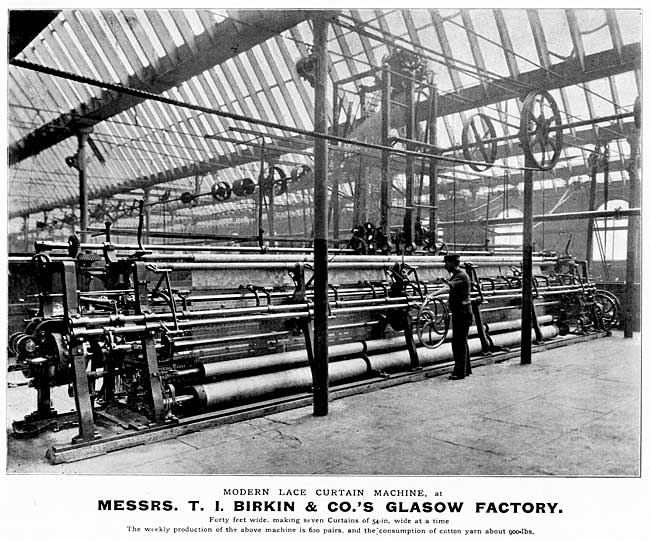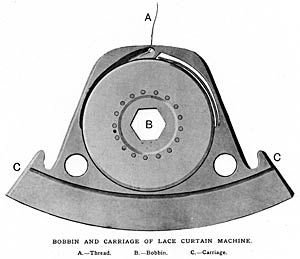< Previous | Contents | Next >


The cotton yarn after being taken out of the bundles is given to the "winders" to be wound on to wooden bobbins, and here perhaps it may be as well, for the sake of clearness, to explain that an ordinary lace curtain is composed of three distinct component threads—No. 1, the bobbin thread No. 2, the warp thread; and No. 3, the spool thread. We have used the word "ordinary" because there are one or two other classes of lace curtains made in which extra threads are used to produce additional effects, but the description of them would not in any way add to the interest of these notes. Of the three kinds of thread above named, the bobbin thread serves to twist round and bind together the other two threads. The second, as its name implies, forms the warp, or foundation of the fabric, and gives it strength and regularity. The third is the spool thread, and of this thread the cloth work, or pattern, of varying density, of the fabric is composed, and also the ties forming the ground or network connecting the pillars together. The spool yarn is wound directly from the hank on to wooden bobbins, or "spools," as they are technically called, and these spools are placed on wires, on which they revolve, which are fixed at regular intervals on large boards or stands at the back of the machine. The yarn for the warp is wound first on to small wooden bobbins, and from there on to a large metal cylinder or "beam" corresponding exactly to the length of the machine. One of these beams in a machine of medium gauge (360m. wide) would contain 9,450,000 yards of yarn weighing 450llbs. The threads are wound on to this beam at regular intervals regulated by the gauge of the machine. For example, in a 10-pt. gauge there are ten warp threads to the inch, and the same remark pplies to both spool and bobbin threads, extending across the whole width of the machine. The bobbin threads are subjected to a more complicated and much more interesting process, and here it will be necessary to describe an integral portion of the lace curtain machine itself—viz., the bobbins and carriages, which are instruments for carrying into effect the under-lying principle on which all twist machine-made lace is manufactured. This description will be better understood by a reference to the annexed illustration—"B," brass bobbin; "C," carriage holding the same; and, "A," the thread contained on the bobbin. The bobbins are brass receptacles formed by rivetting together two discs round the central space, in the middle of which is cut a square or sexagonal hole, the purpose of which will be seen later. These discs are turned out on the inner side in such a way as to form a hollow-chamber when two halves are rivetted together, and some idea of the accuracy required in this operation may be gathered from the fact that, although on a fine-gauge machine thirty-two of these bobbins, placed side by side, close together, only measure 1in.; each one holds 120 yards of cotton yarn. The winding of the yarn on to these brass bobbins requires somewhat delicate manipulation, as on this process depends to a great extent the regularity and equality of tension of the fabric itself. The process is roughly as follows:—What is technically known as a "brass-winding engine" is employed, which contains a spindle of about 15m. long, of the same sshape as the central space in the brass bobbin—that is to say, either square or sexagonal, and on to this spindle brass bobbins, to the number of 120 at a time, are placed. The spindle is then placed in its bearings, and the threads from the wooden bobbins, which are placed on upright wire spindles, arranged in quadrant form, are drawn by the brass winder (usually a girl) over the row of bobbins till each thread stands over its corresponding bobbin. By continued manipulation the threads are finally inserted, each one into a bobbin, and, power being applied, the thread is gradually wound from the wooden bobbins on to the brass bobbins until the requisite number of yards has been put on, which fact is indicated by a dial and bell. As each lot of bobbins are thus wound they are taken off the spindle and placed in the carriages by youths, technically called "threaders," and the process is repeated until enough bobbins have been wound to complete the set or number required to fill the machine from end to end.
